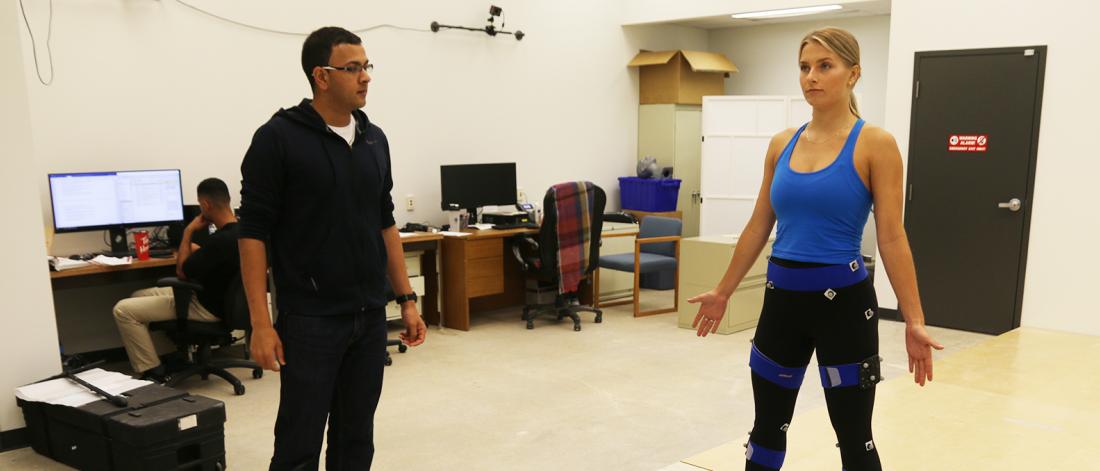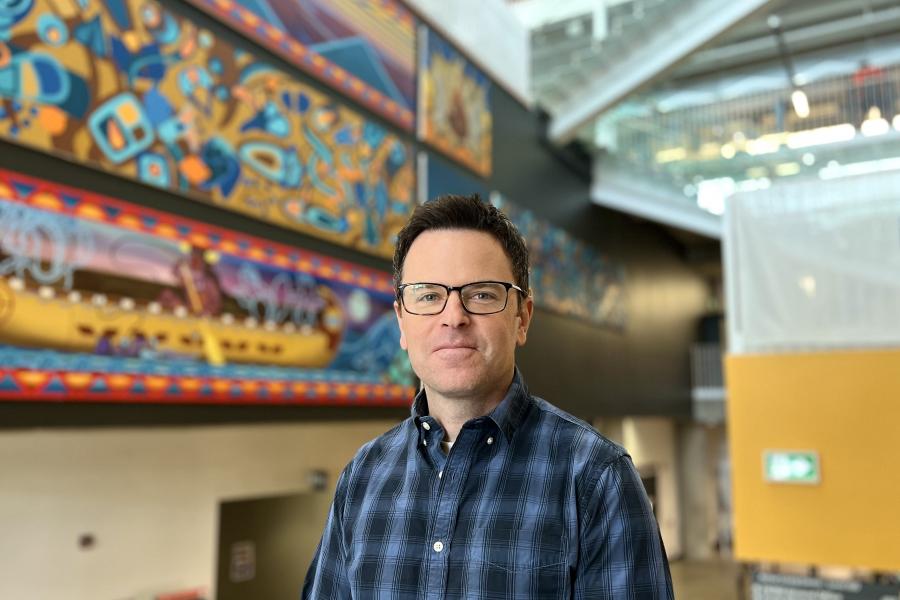Jonathan Singer, PhD
204-474-8469
jonathan.singer@umanitoba.ca
Biomechanics of Balance and Mobility Lab
Objectives
The Biomechanics of Balance and Mobility Lab aims to understand how individuals control and maintain dynamic stability during normal activities of daily living and under situations that pose a considerable balance challenge. We use this information to identify the biomechanical factors that may lead to increased fall-risk among clinical populations, such as older adults and stroke survivors. The long-term goal is to use these findings to inform the development of exercise-based balance rehabilitation programs, targeted at an individual’s specific control challenges.
Address
-
179 Extended Education
University of Manitoba
Winnipeg, MB
R3T 2N2

Areas of focus
Dr. Singer uses kinetic, kinematic and electromyographic outcome measures to understand human stability control during tasks such as quiet unperturbed standing, compensatory stepping and steady-state gait. The laboratory is equipped with a 16-camera Vicon motion analysis system, 4 walkway-embedded Kistler force platforms, a Bertec fully-instrumented split-belt treadmill, two 8-channel Bortec EMG bioamplifiers, a GAITRite portable pressure sensitive walkway and various strain-gauge based force transducers.
Key Areas of Research
- Biomechanics
- Neuromechanics
- Aging
- Postural Control
- Dynamic Stability
- Human Locomotion
Current research projects
Characterising Whole Body Stability Control
Whole-body centre of mass dynamics and whole-body stability are dictated by global factors such as the magnitude, direction and timing of the net ground reaction force arising from the interaction of both limbs with the ground. This series of experiments, performed across a range of tasks, simultaneously quantifies the cause of instability (i.e. force generation) and the subsequent effect (i.e. centre of mass kinematics), to understand the proactive and reactive components of stability control. This work helps identify the origins of instability among individuals at risk of falling.
Modelling Individual-Limb Contributions to Dynamic Stability
While whole-body stability is ultimately regulated by global kinetic variables, such variables themselves arise from more local variables acting at the level of the individual limb, joint and muscle. This line of work aims to understand how local, joint- and muscle-level, variables directly influence dynamic stability, as measured through centre of mass kinematics. Identifying the links between local biomechanical variables and whole-body stability is a necessary precursor to the development of targeted exercise-based balance interventions and technologies.
Understanding Neuromechanical Contributions to Dynamic Stability
Stability control results from a complex relationship between sensory systems, which detect instability, and the mechanical system, which carries out and constrains movement. Age-related alterations to either the neural or the mechanical system can lead to challenges in maintaining stability and a greater risk of falls. We have previously demonstrated that the CNS is capable of recalibrating its internal representation of lower limb segmental mechanical properties to achieve coordinated intersegmental kinematics during both balance and locomotion. Future work will aim to develop novel metrics capable of quantifying the role of specific sensory information in guiding reactive stability control.
Primary investigator
Students
Haydn Christiansen Burdeny - Thesis Title: Does low back pain compromise trunk control and dynamic stability in temporally urgent balance reactions?
Laine Dux - Thesis Title: Understanding the role of lower limb kinetic adaptations in dynamic stability during novel forward walking.
Daria McKennitt - Thesis Title: TBD
Asher Mendelsohn - Thesis Title: Determinants of failed compensatory stepping balance reactions: Implications for age-related challenges in control.
Ramius Sy - Thesis Title: Intersegmental moment and power contributions to dynamic stability during the restabilisation phase of compensatory stepping.
Lab alumni
- MSc. Kinesiology
- Andrew Lesany
-
- Thesis Title: The effect of ankle restriction on whole-body dynamic stability and intersegmental control
- Current Position: Research Assistant, Biomechanics and Balance and Mobility Lab, Faculty of Kinesiology and Recreation Management, University of Manitoba
- Alixandra Bellemare
-
- Thesis Title: The effects of fatigue on consecutive unilateral and bilateral jump task execution
- Current Position: Clinical Research Coordinator, Children’s Hospital Research Institute of Manitoba
- Derek McLennan
-
- Thesis Title: The evaluation of between-limb symmetry and reactive balance control measures as diagnostic tools for concussion in young ice hockey players
- Current Position: Territory Sales Manager, Trudell Healthcare Solutions, Winnipeg, Manitoba
- Yash Rawal
-
- Thesis Title: Age-related changes in mediolateral dynamic stability during walking
- Current Position: Research Coordinator, Children’s Hospital Research Institute of Manitoba, University of Manitoba
- Senior Theses, Graduation Projects
- Daria McKennitt, BKin, Faculty of Kinesiology and Recreation Management, University of Manitoba
-
- Thesis Title: Examining the biomechanical mechanisms of standing balance and voluntary sway movements in adjunction with rhythmic auditory stimuli through the process of entrainment.
- Current Position: MSc Student, Biomechanics of Balance and Mobility Lab, Faculty of Kinesiology and Recreation Management, University of Manitoba
- Savannah Pohl, BKin, Faculty of Kinesiology and Recreation Management, University of Manitoba
-
- Thesis Title: Examining how sensory perturbations can affect the restabilisation phase of compensatory stepping
- Current Position: MPT student, College of Rehabilitation Sciences, University of Manitoba
- Meagan Smith, BSc, Faculty of Science, Department of Neuroscience, University of Winnipeg
-
- Thesis Title: Age related challenges in quiet standing reactive control during visual, somatosensory and vestibular perturbations
- Current Position: MSc (Neuroscience), University of Calgary
- Ryan Mathieson, BKin, Faculty of Kinesiology and Recreation Management, University of Manitoba
-
- Thesis Title: Examination of the biomechanical mechanisms involved in balance recovery responses in athletes involved in stability demanding sport
- Current Position: MSc (Kin), University of Calgary
- Jackson Mortimer, BSc, Biosystems Engineering. Faculties of Engineering and Agricultural and Food Sciences, University of Manitoba.
-
- Grad Project Title: Analysis of throwing kinematics and the relation to UCL injury measures generated by MotusBASEBALL
- Current Position: Manufacturing Engineer at BOMImed
- Hunter Loewen, BSc, Biosystems Engineering. Faculties of Engineering and Agricultural and Food Sciences, University of Manitoba.
-
- Grad Project Title: Effect of Dancers’ Footwear and Landing Conditions on Force Propagation and Balance Measures During Jump-Landing
- Current Position: Resident Physician (Physiatry), University of Calgary
- Sarah Slagerman, BSc, Biosystems Engineering. Faculties of Engineering and Agricultural and Food Sciences, University of Manitoba.
-
- Grad Project Title: Effects of Visual Stimulation on Reactive Standing Balance Control Using Wavelet Transformation
- Current Position: Quality Improvement and Research Coordinator, George and Fay Yee Centre for Healthcare Innovation, University of Manitoba
- Undergraduate Research Award (URA) Students
- Daria McKennitt, FKRM
-
- Research Topic: The influence of entrainment on between-limb coordination in standing balance
- Emily Morrison, FKRM
-
- Research Topic: The interaction between proactive and reactive control in compensatory stepping
- Meagan Smith, Faculty of Science, Neuroscience, University of Winnipeg
-
- Research Topic: Are time-dependent changes in proactive and reactive between-limb coordination patterns indicative of instability in standing balance?
- Sundeep Rakhra, Department of Microbiology
-
- Research Topic: The effect of ageing on between-limb centre of pressure coordination in standing balance: Is there evidence for reactive control challenges among older adults?
- Savannah Pohl, FKRM
-
- Research Topic: Can reactive control indices in standing balance predict effective restabilisation in compensatory stepping
- Preston Tran, FKRM
-
- Research Topic: The Acute Effects of Fatiguing Exercise on Reactive Balance
- Brett Whitla, FKRM
-
- Research Topic: On the relationship between lab-based balance stability metrics and clinical balance test scores
Publications
Full publication list here.

